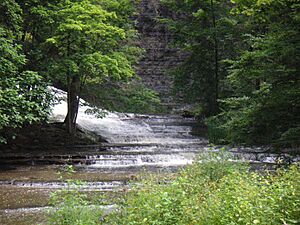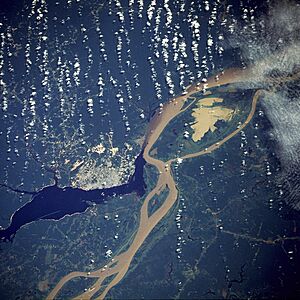Upland and lowland facts for kids

Upland and lowland are terms that describe how high a piece of land is above sea level. When scientists study freshwater rivers and their habitats, they often sort them into upland or lowland types. These two types of areas are very different and are home to different kinds of plants and animals.
Contents
What Are Uplands and Lowlands?
Uplands and lowlands are parts of a plain that are described by their height above the sea level. Lowlands are usually not much higher than 200 meters (about 650 feet). Uplands are typically between 200 meters and 500 meters (about 650 to 1,640 feet) high. Sometimes, a lowland area can even be below sea level, like the Caspian Depression.
Upland areas often have valleys and mountains, forming mountain ranges. Lowland areas are usually quite flat. However, both can have different shapes, like the Mongolian Plateau which is a high, flat area.
River habitats in uplands are often cold, clear, and rocky. Their rivers flow very fast because they are in mountainous areas. Lowland river habitats are warmer and have slow-flowing rivers. The water in lowland rivers is often colored by sediment (tiny bits of rock and dirt) and other natural materials.
Scientists who study freshwater ecosystems find it important to classify rivers as upland or lowland. This is because the two types of river habitats are very different. They usually support very different kinds of fish and tiny water creatures (invertebrates).
Exploring Upland Rivers
In freshwater science, upland rivers and streams are the fast-flowing ones. They flow down from high or mountainous areas, often onto wide, flat plains. When they reach these plains, they usually become lowland rivers.
The height of the land is not the only thing that makes a river upland. The most important things are how much "stream power" the river has and how steeply it drops. Stream power is like the force of the water. Rivers that drop quickly in height will have faster water flow and more stream power.
This strong flow creates other features of an upland river:
- A deep, cut-out path.
- A river bed made mostly of solid rock and large rocks or pebbles.
- Areas of fast, shallow water called "riffles" mixed with deeper, slower "pools."
- Cooler water temperatures.
The clear, cool, and fast-flowing waters of upland rivers are perfect for certain fish species. These fish can't handle warm temperatures, need a lot of oxygen, and are strong swimmers. They also have special ways to lay their eggs so they don't get washed away by the strong current. Tiny water creatures (invertebrates) that live here also need cool temperatures and lots of oxygen. They often live among the rocks and pebbles.
The word "upland" is also used in wetland ecology. There, "upland" plants mean an area that is not a wetland.
Discovering Lowland Rivers
Lowland rivers have water that is often cloudy or turbid, warm, and slow-flowing. Their riverbeds are made of fine sediments like sand and mud. These conditions are good for fish species that can handle a wider range of temperatures and lower oxygen levels. These fish also have life cycles and breeding methods that fit the conditions of lowland rivers.
Tiny water creatures in lowland rivers can also handle different temperatures and lower oxygen. They often live in the fine sediments or in other places like sunken wood or water plants.
Lowland Floodplains
Lowland alluvial plains are flat areas formed over a long time. They are created when one or more rivers coming from higher regions drop off sediment. This sediment builds up in lowland areas for many years. Examples include the American Bottom, which is a floodplain of the Mississippi River in Southern Illinois. Another example is a Bottomland hardwood forest, which is a type of forest found in wide, low-lying floodplains in the United States.
See also
- Freshwater biology
- Highland
- Mountain river
- Riparian zone
- Plateau



